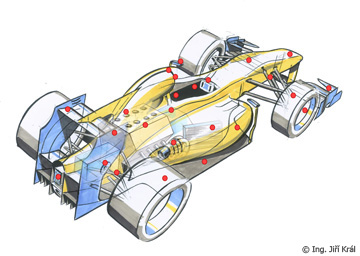WHAT IS SAFETY?
J.Kr├Īl | 10.8.12 | Bezpe─Źnost i v F1
This year's Belgium GP again started disputes about the safety of the F1 drivers. The opinions vary by 180 degrees - from the calls for the closed cockpits and wheels to the positions of the very drivers (Kimi Raikkonen) that such risks are simply a part of formula racing.....
This year's Belgium GP again started disputes about the safety of the F1 drivers. The opinions vary by 180 degrees - from the calls for the closed cockpits and wheels to the positions of the very drivers (Kimi Raikkonen) that such risks are simply a part of formula racing.
I, as a car designer, take a different point of view - what is the cause and what is the result? A catastrophe is usually not a result of one failure but of a chain of them. Romain Grosjean's flying over Fernando Alonso's head is the final effect. The immediate cause was when his Lotus was catapulted into the air, and the cause of that was hooking his wheels. The hooking can be prevented by pontons around them, while they can stay open from the top, so that the car still looks like a formula to the spectators. Another question is why the hooking happened at all, maybe because of braking late. That links with another problem, which Pirelli pointed out when they were returning to F1. The rule's anachronism about the 13 inches rims which does not allow the constructors to use brakes proportionate to the need to slow down from the top speed to fifty kph in a few metres. In fact locking the wheels of Kobayashi's Sauber after the formation lap was the primary reason for the traffic jam in the first corner. Moreover, with a tire burst its not possible to finish the lap without damaging the floor, again worsening the safety. You may object that none of this can save the drivers from a torn wheel flying around. But why do the torn wheels fly around? Mainly from the time when the F1 constructors began using carbon composites for the suspension. A steel arm may bend at a lower stress load, but corruption of a composite one (even if at higher stress load) leads to a total destruction and the wheel tearing away. There is an argument for these designs claiming the experience of F1 for road cars. What is, however, a link between a 13" rim on a composite arm in F1 and a 21" rim on a steel suspension of a stock supersport? Or the KERS or DRS? The F1 rules are in abundance of all kinds of defined dimensions, however they do not deal with the almost hundred per cent probability of a tire defect when it touches the front wing nor other collateral defects when they hit the debris of sharp carbon parts. Therefore one of the solutions could be in the form of material restrictions on the chasis or body construction (similarly to the USA) or, in case of the front part, a shape preventing the tires from being cut. Similarly, we could continue to other F1 rules. Even the insiders of this circus start talking about limiting the constructors' creativity in favour of demanding and expensive tuning the details in aerodynamic tunnels or CFD simulations. For example, the weight distribution in the range of a half of a per cent between the front and the rear axle is officially meant to prevent giving an unfair advantage to somebody with a better guess. The tests were prohibited to limit the costs. The teams substituted them with simulators and 60% models measurements in aerodynamic tunnels, whereas such a model is more expensive than a GP2 car. Then you might ask if it would not be better for the safety (and also lower costs) to test real cars together with the ban on simulators and the use of aerodynamic tunnels?
In the following picture you can see a possible solution of the situation, without loosing the charm of a formula car with open wheels and cockpit for the driver. We are paying a special attention to the active safety which prevents the critical situations. The elements of the passive safety (e.g. front roll structure or a polycarbonate shield) do just the damage control. Apart from the already mentioned pontons, brakes, tires there is another important player, the slip stream behind the car, as it influences the grip of the front axle in the suspension which effects its handling and consequently safety, especially at the entry into the corner. The aerodynamics elements integrated into the body give the same downforce with a clearer slip stream behind the car, moreover there is no danger of them breaking away and the following loss of grip and control over the car.




